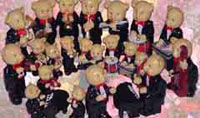Francisco Goya, フランシスコ・デ・ゴヤ
Above is just a small part of our gift-packed souvenir stamp-collection; inquire by email if the picture or subject of your interest is not here: we will be obliged to accomodate your wishes.
ここに掲載の写真は一部のみです。ご希望のジャンル、絵柄などございましたらお問い合わせください。
フランシスコ・ホセ・デ・ゴヤ・イ・ルシエンテス(Francisco Jose´ de Goya y Lucientes, 1746年3月30日 - 1828年4月16日)は、スペインの画家。ディエゴ・ベラスケスとともに、スペイン最大の画家。べラスケス同様、宮廷画家として重きをなした。
生涯
1746年、スペイン北東部サラゴーサ近郊のフエンデトードスに生まれる。14歳の時から約4年間、サラゴーサで地元の画家に師事して絵画の修行をする。この間、のちにゴヤの義兄となる、兄弟子・フランシスコ・バエウ(バイユー)に出会う。
27歳の時、バエウの妹ホセーファと結婚。
1774年、バエウの手引きでマドリードへ出て、1775年から十数年間、王立タペストリー工場でタペストリーの下絵描きの仕事に携わる。
着衣のマハ(1797年-1803年頃)(プラド美術館)
裸のマハ(1797年-1800年頃)(プラド美術館)
このように、40歳台にさしかかって、ようやくスペイン最高の画家としての地位を得たゴヤは、1792年、不治の病に侵され、聴力を失う。今日、ゴヤの代表作として知られる『カルロス4世の家族』、『着衣のマハ』、『裸のマハ』、『マドリッド、1808年5月3日』、『巨人』などはいずれも、ゴヤが聴力を失って以後の後半生に描かれたものである
1786年、40歳で国王カルロス3世付き画家となり、1789年には新王カルロス4世の宮廷画家となる。
マドリッド、1808年5月3日(1814年)(プラド美術館)
1807年、ナポレオン率いるフランス軍がスペインを侵略し、翌1808年にはスペイン王フェルナンド7世を退位させて、ナポレオンの兄ジョーゼフがホセ1世としてスペイン王位についた。事実上、ナポレオン軍の支配下に置かれたスペインは、1808年から1814年にかけて半島戦争のさなかにあった。
こうした動乱の時期に描かれたのが『マドリッド、1808年5月3日』、『巨人』などの作品群である。1810年には版画集『戦争の惨禍』に着手している。1815年、すでに69歳に達していたゴヤは、40歳以上も年下のレオカディアというドイツ系の家政婦と同棲していた(ゴヤの妻はその3年ほど前に死去)。
1819年にはマドリード郊外に「聾者の家」と通称される別荘を購入した。1820年から1823年にかけて、この「聾者の家」のサロンや食堂を飾るために描かれた14枚の壁画群が、今日「黒い絵」と通称されるものである。
当時のスペインの自由主義者弾圧を避けて1824年、78歳の時、フランスに亡命。1828年、亡命先のボルドーにおいて82年の波乱に満ちた生涯を閉じた。
カルロス4世とその家族を描いた集団肖像画は、一見普通の宮廷肖像画にみえるが、仔細にみると、いかにも暗愚そうなカルロス4世の風貌や、狡猾で底意地の悪そうな夫人の表情などには、ゴヤの精一杯の風刺が感じられる。
Goya painted the Spanish royal family, including Charles IV of Spain and Ferdinand VII. His themes range from merry festivals for tapestry, draft cartoons, to scenes of war, fighting and corpses. This evolution reflects the darkening of his temper. Modern physicians suspect that the lead in his pigments poisoned him and caused his deafness since 1792. Near the end of his life, he became reclusive and produced frightening and obscure paintings of insanity, madness, and fantasy. The style of these Black Paintings prefigure the expressionist movement. He often painted himself into the foreground.
The Nude Maja.
The Clothed Maja.
Two of Goya's best known paintings are The Nude Maja (La Maja desnuda) and The Clothed Maja (La Maja vestida). They depict the same woman in the same pose, naked and clothed respectively. He painted La Maja Vestida after outrage in Spanish society over the previous Desnuda. He refused to paint clothes on her, and instead created a new painting. ((La Maja vestida). They depict the same woman in the same pose, naked and clothed respectively. He painted La Maja Vestida after outrage in Spanish society over the: Majo.)
In a period of convalescence during 1793-94, he completed a set of 11 small pictures painted on tin, called the pictures of “Fantasy and Invention” that mark a change in his art. These paintings no longer represent the world of popular carnival, but rather a dark, dramatic realm of fantasy and nightmare. "Courtyard with Lunatics" is a horrifying and imaginary vision of loneliness, fear and social alienation, a departure from the rather more superficial treatment of mental illness in the works of earlier artists such as Hogarth. In this painting, the ground, sealed by masonry blocks and iron gate, is occupied by patients and a single warden. The patients are variously staring, sitting, posturing, wrestling, grimacing or disciplining themselves. The top of the picture vanishes with sunlight, emphasizing the nightmarish scene below.
This picture can be read as an indictment of the widespread punitive treatment of the insane, who were confined with criminals, put in iron manacles, and subjected to physical punishment. And this intention is to be taken into consideration since one of the essential goals of the enlightenment was to reform the prisons and asylums, a subject common in the writings of Voltaire and others.
This condemnation of brutality towards prisoners (whether they were criminals or insane) was the subject of many of Goya’s later paintings.
As he completed this painting, Goya was himself undergoing a physical and mental breakdown. It was a few weeks after the French declaration of war on Spain, and Goya’s illness was developing. A contemporary reported, “the noises in his heads and deafness aren’t improving, yet his vision is much better and he is back in control of his balance.” His symptoms may indicate a prolonged viral encephalitis or possibly a series of miniature strokes resulting from high blood pressure and affecting hearing and balance centers in the brain.
In 1799 he created a series of 80 prints titled Los Caprichos depicting what he called "the innumerable foibles and follies to be found in any civilized society, and from the common prejudices and deceitful practices which custom, ignorance, or self-interest have made usual."[1]
In The Third of May, 1808: The Execution of the Defenders of Madrid, Goya attempted to "perpetuate by the means of his brush the most notable and heroic actions of our glorious insurrection against the Tyrant of Europe"[1] The painting does not show an incident that Goya witnessed; rather it was meant as more abstract commentary.
In later life Goya bought a house (Quinta del Sordo - the Deaf Man's House) and painted many unusual paintings on canvas and on the walls, including references to witchcraft and war. One of these is the famous work Saturn Devouring His Sons, which displays a Greco-Roman mythological scene of the god Saturn consuming a child, a reference to Spain's ongoing civil conflicts. This painting is one of 14 in a series called the Black Paintings. After his death the wall paintings were transferred to canvas and remain some of the best examples of the later period of Goya's life when, deafened and driven half-mad by what was probably an encephalitis of some kind, decided to free himself from painterly strictures of the time and paint whatever nightmarish visions came to him. Many of these works are in the Prado museum in Madrid.
In the 1810s Goya created a set of aquatint prints titled Los Desatres de la Guerra (The Disasters of War) which depict scenes from the Peninsular War. The prints were published in 1863, 35 years after his death.
The above explanation comes from

出典: フリー百科事典"ウィキペディア"

